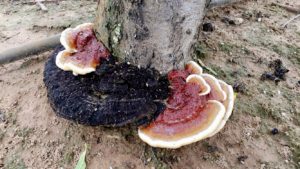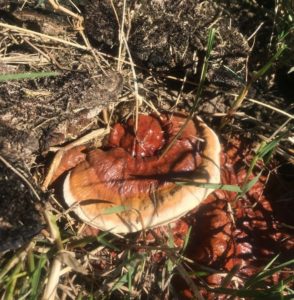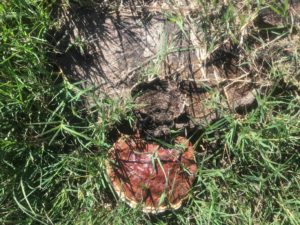Written by Javier Garza – TPDDL Student Worker;
Edited by Hannah Ayala – Extension Assistant
Ganoderma rot is caused by the genus of fungi Ganoderma, a basidiomycete which has several species that cause the disease (G. zonatum, G. applanatum, G. lucidum). Ganoderma spp. have a wide range of hosts and can attack gymnosperms, woody dicots, and even some palms. However, oaks, maples, and honeylocusts are particularly susceptible to this disease. The symptoms of Ganoderma spp. may include yellowing, stunted growth, wilting, dead branches, or a high proportion of dead leaves in the lower canopy. During heavy winds, affected trees are also highly susceptible to being blown down. The tell-tale sign of Ganoderma rot is the formation of a large fruiting body, known as a conk, which forms on the trunk of the tree. These conks are especially visible during these rainy times. You might see one or several on affected trees after a rainstorm. Conks are produced annually, usually in the summer and fall. Spores of the fungus are spread by the wind and rain and they typically affect trees that are weakened or that have mechanical damage done to them.

Unfortunately, there is no control for the disease once the tree has become infected. Due to the nature of the fungus, once a tree has it, the tree’s health will slowly decline. Ganoderma spp. are wood-rooting basidiomycetes, meaning that they are able to produce enzymes that break down cellulose and lignin within the sapwood of the tree. This break down of cellulose and lignin in the tree will lead to poor structural stability. The first sign of the disease is usually the formation of the conk on the tree and the fungus will feed on the sapwood from within. At this point, the tree is most likely structurally compromised.
Being proactive is the best way to prevent this disease in the landscape. Confirm that, when possible, resistant cultivars are being used. Best management practices include proper planting, fertilization, watering routine, and pruning to make sure that the tree maintains good health and vigor. Avoid common errors like creating mulch volcanoes around the base of the tree and ensure that roots flares are exposed and not buried. During landscape maintenance, avoid damaging the trunk in any way. Mowers and weed-whackers have the potential to damage the trunk and all it takes is one open wound for the fungal spores to enter and infect the tree. If you think your tree is infected, call a professional such as an ISA certified arborist to inspect the tree. Trees infected with Ganoderma rot may require felling so that they don’t pose a threat to nearby structures. Here are some pictures of the Ganoderma growing on a stump outside our lab!


For more information on Ganoderma Butt Rot check out our video using this link: https://youtu.be/rJjiSd9wlLk



